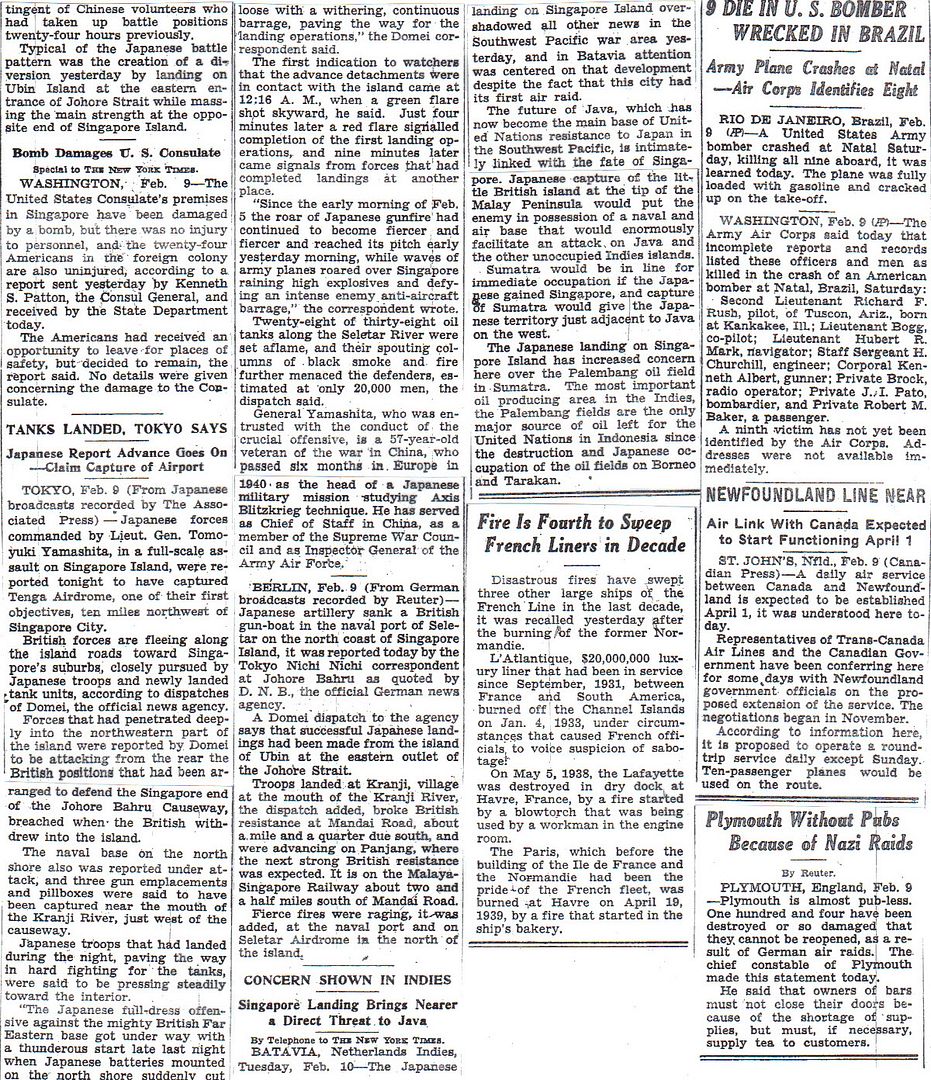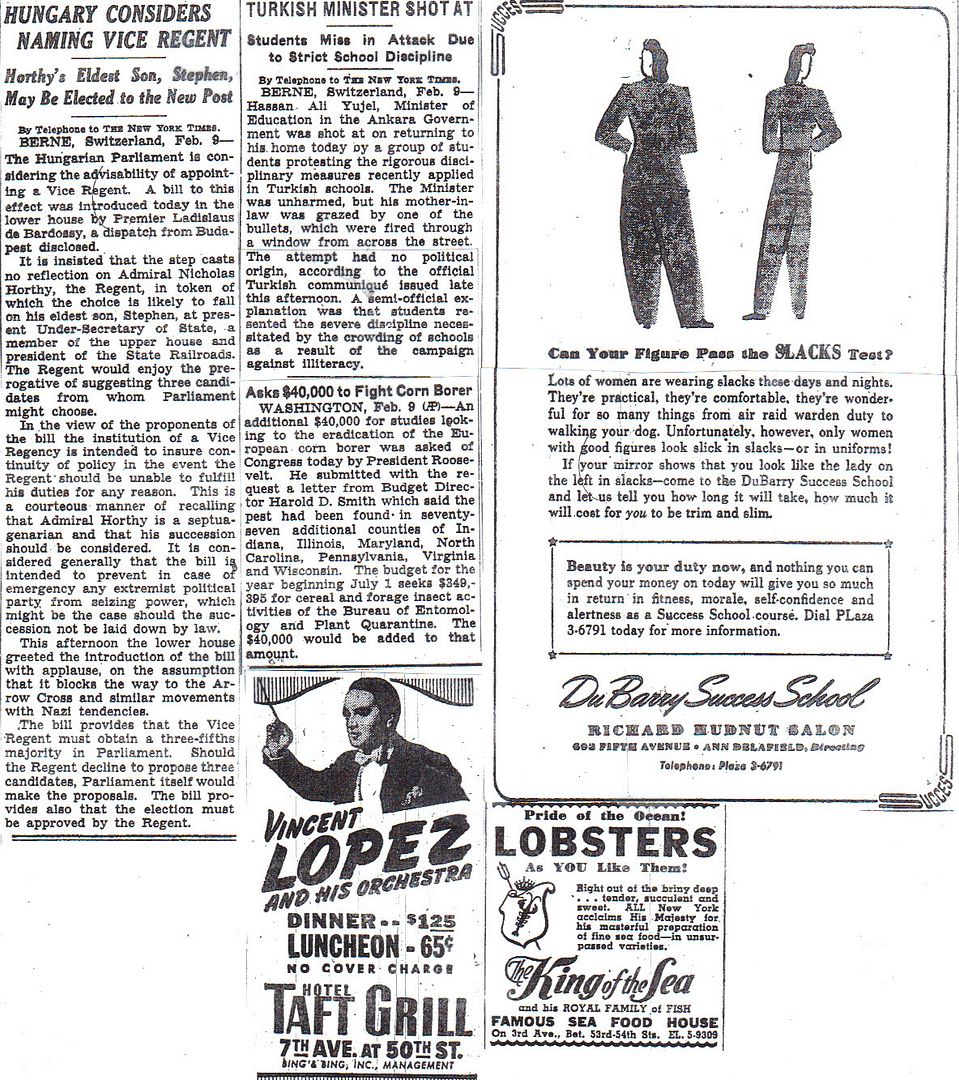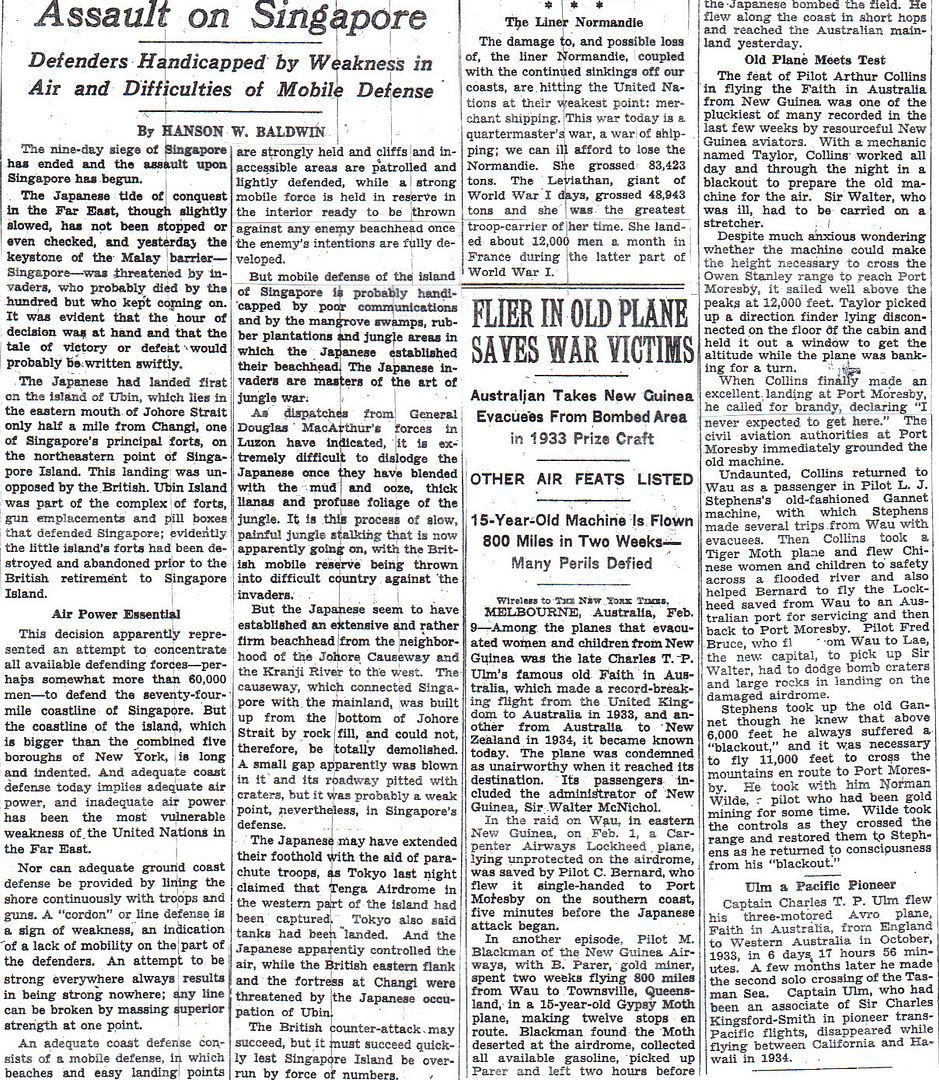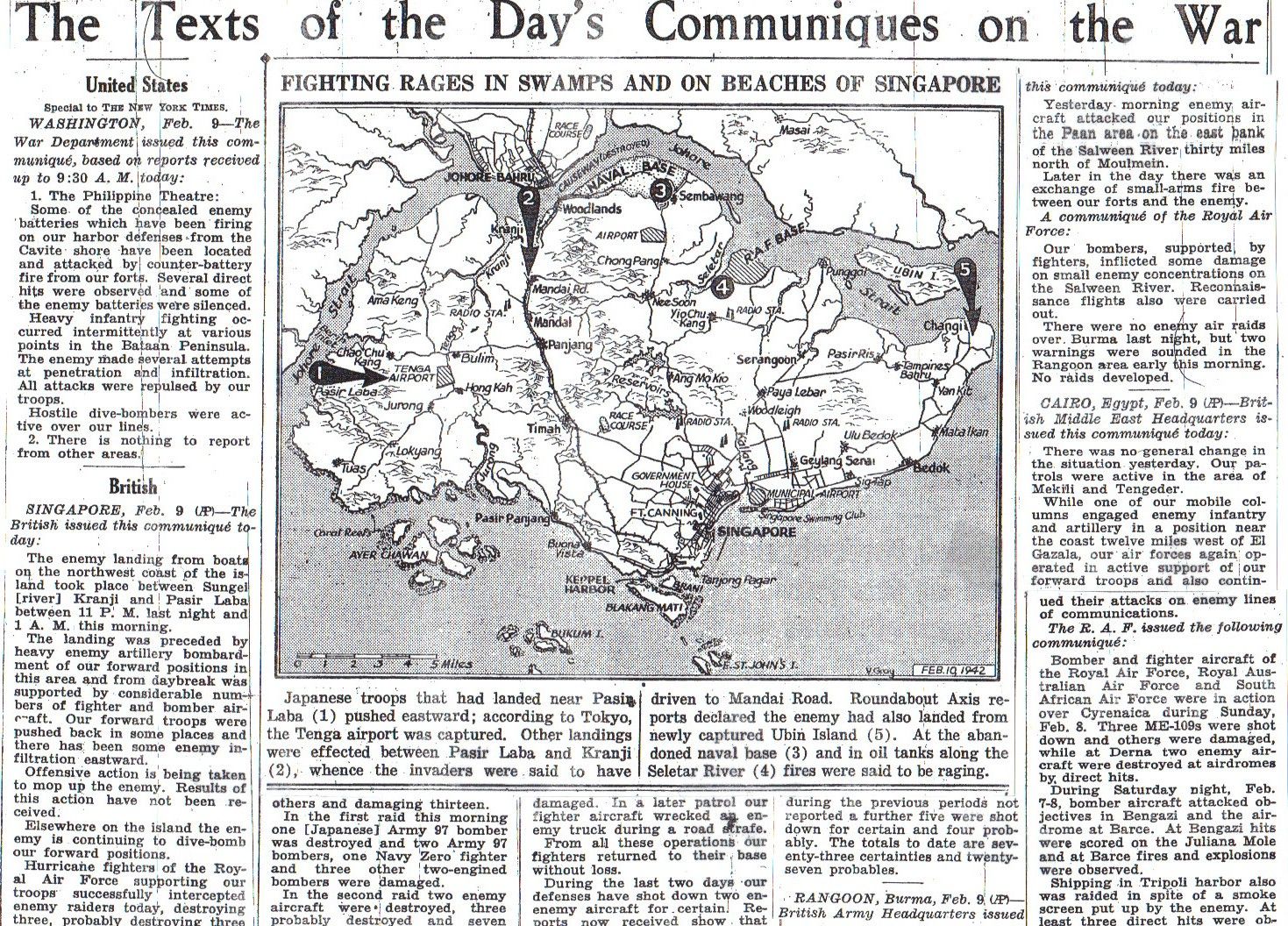
Posted on 02/10/2012 4:38:36 AM PST by Homer_J_Simpson












http://www.onwar.com/chrono/1942/feb42/f10feb42.htm
Japanese advancing in Burma
Tuesday, February 10, 1942 www.onwar.com
Japanese forces cross the Salween RiverIn Burma... The Japanese cross the Salween River near Martaban and Pa-an.
In Malaya... Due to confusion, the Allied forces on Singapore Island facing Japanese attack withdraw farther than needed, abandoning strongholds along the Jurong Line. Fighting continues on the island.
In London... The first meeting of the Pacific War Council is held. Representatives from Britain, New Zealand, Holland and Australian attend.
In the United States... The Lafayette capsizes in New York harbor after catching fire on Monday.
http://homepage.ntlworld.com/andrew.etherington/month/thismonth/10.htm
February 10th, 1942
UNITED KINGDOM: The first meeting of the Pacific War Council in London begins. Represented are Britain, New Zealand, Australia and Holland.
FRANCE: Fifteen bombers of RAF Bomber Command attack the German fleet at Brest visually during the night without loss. (Jack McKillop)
GERMANY: RAF Bomber Command attacks five cities visually during the night without loss: (1) 34 bombers attack Bremen; (2) six attack Emden; (3) and one bomber each attacks Borkum, Cruxhaven and Wilhelmshaven. (Jack McKillop)
U-953, U-954 laid down. (Dave Shirlaw)
CHINA: An 1,100 man US Army defence force occupy Canton with an infantry, coast artillery and AA battalion, followed by one pursuit and one light bomber squadron. Is is assigned APO number SF 914. (Gordon Rottman)
BURMA: The 46th Brigade, Indian 17th Division, which has recently relieved the Indian 16th Brigade along the Salween River in the Martaban area, begins a fighting withdrawal from Martaban toward Thaton, since the Japanese have bypassed Martaban. (Jack McKillop)
SINGAPORE: General Sir Archibald Wavell, Commander in Chief American-British-Dutch-Australian Command, visits Singapore and orders the island held and all remaining RAF personnel withdrawn to the Netherlands East Indies. During the visit he falls off a sea wall, injuring his back. The Japanese deepen their penetration to the supply depot area. The Australian Imperial Force Malaya, which is further reinforced in the Western Area, begins withdrawing from the Causeway sector at 0430 hours and fall back to the line Kranji-Jurong. Between 1900 and 2000 hours, Japanese infantry and tanks attack the Australian 2/29th Battalion and since the battalion lacks anti-tank weapons, the Japanese break through the line and head down the road towards Bukit Timah. (Jack McKillop)
COMMONWEALTH OF THE PHILIPPINES: On Bataan, the I Corps is rapidly reducing Big Pocket while South Sector forces are compressing the Japanese in the Anyasan-Silaiim area. (Jack McKillop)
NETHERLANDS EAST INDIES: On Borneo, a Japanese landing force takes Banjarmasin and a nearby airfield on the south coast. The Japanese are only 280 miles (451 kilometres) from Java and their planes soon will dominate the Java Sea. (Jack McKillop)
USAAF 5th Air Force LB-30 Liberators bomb and damage the Japanese seaplane carrier HIJMS Chitose in Makassar Strait south of Celebes Island. (Jack McKillop)
PACIFIC OCEAN: LINE ISLANDS: A small U.S. Army defence force arrives on Christmas Island. The force consists of 2,000 troops (one each infantry, coast artillery and antiaircraft artillery battalions) plus the USAAF 7th Air Force’s 12th Pursuit Squadron (Interceptor) with P-39Airacobras. (Jack McKillop)
MIDWAY: The Japanese submarine HIJMS I-69 shells Midway but is immediately bombed and damaged by F2A Buffaloes of Marine Fighting Squadron Two Hundred Eleven (VMF-211) based on the island. (Jack McKillop)
AUSTRALIA: Commander Alvord Sydney Rosenthal RAN of HMAS Nestor is awarded the first bar to his DSO, for ‘skill and enterprise’ in sinking U-127 on 15 December, 1941 off Cape St. Vincent. (G. A. Mackinley)
CANADA: Corvette HMCS Timmins commissioned. (Dave Shirlaw)
U.S.A.: New York: The impounded French liner Normandie capsizes after catching fire; Axis sabotage is suspected.
Chesterfield Radio broadcasts the RCA Victor band leader Glenn Miller and his orchestra receiving the first ever gold record awarded for the 1,200,000th sale of “Chattanooga Choo-Choo”. A figure reached in less than a year. (Jack McKillop)
Washington: Secretary of War Henry Stimson writes in his diary: “The second generation Japanese can only be evacuated either as part of a total evacuation, giving access to the areas only by permits, or by frankly trying to put them out on the ground that their racial characteristics are such that we cannot understand or even trust the citizen Japanese. This latter is the fact but I am afraid it will make a tremendous hole in our constitutional system to apply it.”
C. February 10, 1942: Attorney General Francis Biddle is advised by agency lawyers that removal of people of Japanese descent from Pacific Coast areas would be a legal exercise of the President’s war powers. (Scott Peterson) More...
The US Navy’s Second Joint Training Force is renamed to Amphibious Force, Pacific Fleet. (Gordon Rottman)
ATLANTIC OCEAN: Canadian corvette HMCS Spikenard is torpedoed and sunk by U-136 off Iceland; 57 crewmen are lost. (Jack McKillop)
SS Victolite (11,410 GRT) Canadian Imperial Oil Shipping Company tanker was torpedoed and subsequently sunk northwest of Bermuda in position 36.12N, 067.14W, by gunfire from U-564, ObLtzS Reinhard Suhren, Knight’s Cross, Knight’s Cross with Oak Leaves, Knight’s Cross with Oak Leaves and Swords. There were no survivors from her crew of 47. Victolite was sailing in ballast alone from Halifax to Uruguay to load diesel fuel. The ship exploded when hit, due to the explosive vapours in her empty tanks.
In the frigid North Atlantic waters between Iceland and Ireland lies Convoy SC-67: 22 merchant ships bound for Liverpool at five to eight knots in good weather—and the weather on this trip is miserable. The merchantmen are organized in a rectangle of seven columns, three to four ships deep, and spread across almost a mile and a half of frontage. They are escorted by Task Force 4.1.15, six Canadian corvettes that zigzag along the fringes of the convoy listening and watching for submarines. So far there has been no sign of U-boat activity and this is the last night of escort duty for the corvettes; in the morning the convoy will reach the Mid-Ocean Meeting Point, where a British escort group takes over. The starboard side of the convoy is screened by the senior corvette, HMCS Spikenard (Lieutenant-Commander Herbert G. Shadforth), stationed well ahead of the starboard column of merchantmen, followed by HMCS Louisburg, keeping station 2,000 yards abeam of the lead merchantman, and HMCS Dauphin (Lieutenant R.A.S. MacNeill) nearly three miles behind Spikenard and astern of the last ship in the column to prevent straggling. Miles away on the port wing, set out in similar order, are HMC Ships Chilliwack, Lethbridge and Shediac. The weather is foggy and very cold, and there is no moon. At 2230 hours, Chilliwack picks up U-boat noise and goes to action stations to attack the contact. At the same instant, all hell breaks loose in the starboard column, where a torpedo strikes the Norwegian tanker Heina, which immediately bursts into flames. The lookout in Louisburg sees the torpedo whizz past her port side, missing by a few feet, while the ASDIC operator locates a contact. Louisburg turns on the torpedo track and starts hunting the U-boat. Meanwhile, peering through the fiery glow from Heina, Lt MacNeill spots what may be another explosion. His first priority is rescuing the crew of Heina, however, for the next two hours he and his crew struggle with scramble nets and Carley floats to pluck the merchant sailors from the oily water. When Shediac eventually arrives to help, Lt MacNeill sends her to search for the victim of that possible second explosion. He thinks it may be Spikenard. Throughout the night, with its alarms and dangers, not one ship in the convoy risks a wireless message—any radio signal would immediately attract a U-boat. The convoy cannot stop, and the escorts’ first duty is to protect the group, so their search for Spikenard continues only as long as it takes to return to their screening stations. They all try and fail to contact the missing corvette by radio-telephone, but the device is so crude that the most likely reason for her continued silence is equipment failure. Spikenard is still missing at dawn, but there is still hope; she could be looking for the British escort group. At 1100 hours, when they reach the rendezvous, HMS Gentian strikes out on the convoy’s track and, late in the afternoon, she encounters a Carley float with eight Spikenard matelots, all nearly dead from hypothermia. When they are finally able to talk, their story is terrifying. At 2230 hours, when Chilliwack picked up the first contact, Spikenard went to action stations and began to accelerate. When the torpedo that missed Louisburg struck Heina, a second torpedo hit Spikenard between the bridge and forecastle, blowing open her side and top deck. Flames from the initial explosion engulfed the bridge, the wireless office and one of the boats, and then became infinitely worse when it reached the mast, where several drums of gasoline were lashed. The impact set off the ship’s whistle, and its eerie shriek filled the air as Spikenard settled and sank, all in five minutes. The final blow was the explosion of a depth charge or perhaps the boiler, which smashed the remaining boat and one of the Carley floats. The eight men on the second Carley float had no flares, and their voices disappeared in the wind’s howl when they called to the two corvettes that passed them by during the night. Gentian found them purely by chance. (Dave Shirlaw)
I wonder if p6 marks first public mention of what would become the infamous Japanese “knee mortar”?
How to accidentally sink one of the largest and fastest cruise ships of the day (reminds one of the recent Italian disaster)...
http://en.wikipedia.org/wiki/SS_Normandie
The war found Normandie in New York. Soon the Queen Mary, later refitted as a troop ship, docked nearby. Then the RMS Queen Elizabeth joined the Queen Mary. For two weeks the three largest liners in the world floated side by side.[48] In 1940, after the Fall of France, the United States seized the Normandie under the right of angary. By 1941, the U.S. Navy decided to convert Normandie into a troopship, and renamed her USS Lafayette (AP-53), in honor both of Marquis de la Fayette the French general who fought on the Colonies’ behalf in the American Revolution and the alliance with France that made American independence possible.
Earlier proposals included turning the vessel into an aircraft carrier, but this was dropped in favor of immediate troop transport.[49] The ship was moored at Manhattan’s Pier 88 for the conversion. On 9 February 1942 sparks from a welding torch ignited a stack of thousands of life vests filled with kapok, a highly flammable material, that had been stored in the first-class lounge.[50][51] The woodwork had not yet been removed, and the fire spread rapidly. The ship had a very efficient fire protection system but it had been disconnected during the conversion and its internal pumping system was deactivated.[52] The New York City fire department’s hoses also did not fit the ship’s French inlets. All on board fled the vessel.
As firefighters on shore and in fire boats poured water on the blaze, the ship developed a dangerous list to port due to water pumped into the seaward side by fireboats. About 2:45am on February 10, Lafayette capsized, nearly crushing a fire boat.
The ship’s designer Vladimir Yourkevitch arrived at the scene and offered expertise, but he was barred by harbor police.[44][53] His suggestion was to enter the vessel and open the sea-cocks. This would flood the lower decks and make her settle the few feet to the bottom. With the ship stabilised, water could be pumped into burning areas without the risk of capsize. However, the suggestion was denied by port director Admiral Adolphus Andrews.
Enemy sabotage was widely suspected, but a federal investigation in the wake of the sinking concluded that the fire was completely accidental.[54] It has later been alleged that it was indeed sabotage, organized by mobster Anthony Anastasio, who was a power in the local longshoreman’s union. The alleged purpose was to provide a pretext for the release from prison of mob boss Charles “Lucky” Luciano. Luciano’s end of the bargain would be that he would ensure that there would be no further “enemy” sabotage in the ports where the mob had strong influence with the unions.[55]
The ship was stripped of superstructure and righted in 1943 in the world’s most expensive salvage operation. But the cost of restoring her was subsequently determined to be too great. After neither the US Navy nor French Line offered, Yourkevitch proposed to cut the ship down and restore her as a mid-sized liner.[56] This plan also failed to draw backing and the hulk was sold for US$161,680 to Lipsett Inc., an American salvage company. She was scrapped in October 1946.[6]
Disclaimer: Opinions posted on Free Republic are those of the individual posters and do not necessarily represent the opinion of Free Republic or its management. All materials posted herein are protected by copyright law and the exemption for fair use of copyrighted works.